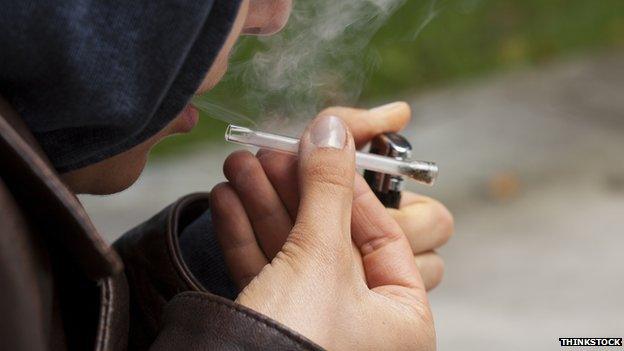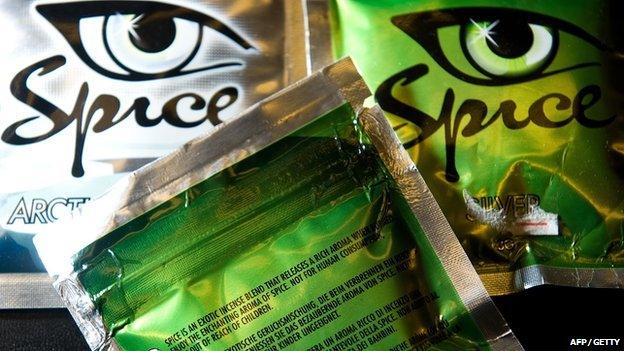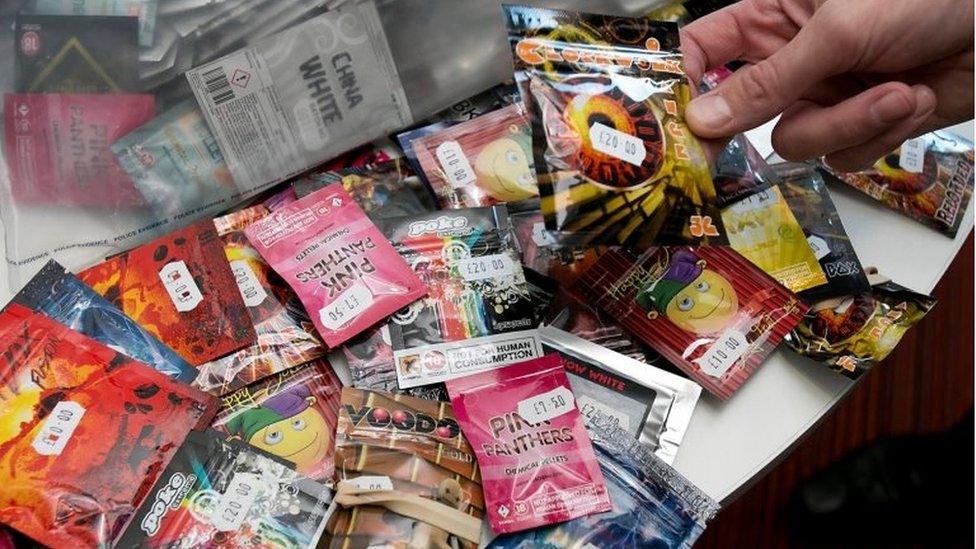What exactly are legal highs?
- Published

Legal highs can be smoked, snorted or swallowed
Producers and suppliers of so-called legal highs will face up to seven years in jail under new legislation introduced across the UK.
Officially described as new psychoactive substances (NPS), legal highs - or designer drugs - have been linked to a number of deaths and hospital admissions over the years.
What are these drugs?
Legal highs are psychoactive drugs that contain various chemical ingredients, some of which are illegal while others are not. They produce similar effects to illegal drugs like cocaine, cannabis and ecstasy.
How are they sold?
They are sold in a variety of forms - powder, pills, liquids, capsules, perforated tabs and smoking mixtures, to name a few. The substances are often sold in "head shops" alongside drug paraphernalia.
There have also been reports of some people injecting legal highs. Because they cannot be labelled as being for human consumption, they are often marketed as plant food, bath salts or incense.
What are their effects?
They are either stimulants (making users feel energised), sedatives (making users feel relaxed or euphoric), or psychedelics (altering perceptions and making users hallucinate).
What are the risks?
The chemicals contained in legal highs have not been tested for safety, so users cannot be sure what the outcome will be. They can cause paranoia, seizures, coma and can also lead to death.
The risks can be increased when legal highs are taken with alcohol or with another psychoactive drug. Legal highs can also be addictive and there are additional risks if they are injected.
Drug advisory service Frank says: "Just because a drug is legal to possess, it doesn't mean it's safe."

Spice stimulants on sale in a London shop
How much of a problem are they?
Research from the Centre for Social Justice (CSJ) showed that there were 97 recorded deaths from legal highs in the UK in 2012, up from 12 in 2009.
The CSJ, an independent think tank, says that the UK has the highest number of legal high users among young people in Europe.
Drug and alcohol treatment charity Addaction says the drugs are often marketed to young people through brightly coloured packaging but are also becoming the "drug of choice" for other users because they are easy to buy.
A 2014 study, external by the United Nations Office on Drugs and Crime, which looked at the issue of NPS abuse on a global scale, said: "The use of NPS that poses a health threat has grown rapidly over the past decade and there have been increasing reports of the availability and manufacture of such substances."
It added that due to the "fast-paced nature of the NPS market" there was a "continued need for analysis of the scope and magnitude of the global synthetic drugs problem".
What does the law say?
The production, distribution, sale and supply of legal highs is now an offence that is punishable by up to seven years in prison, after the Psychoactive Substances Act was brought into effect on 26 May.
Possession of a psychoactive substance is not an offence, except in a "custodial institution", such as prison or young offender centres.
Drug-driving, including after using a legal high, is illegal.
Where have legal highs been banned?
In addition to the UK's ban, in the Irish Republic it is an offence to advertise, sell, supply, import or export psychoactive substances.
Lincoln had already introduced a ban on people taking legal highs in public while other councils, including Newcastle, used licensing powers or trading standards regulations to restrict sales.
Taunton had also banned their use in public places.
Sources: Frank, external, NHS Choices, external, Centre for Social Justice, external, Addaction, externalScottish Drugs Forum, external
- Published26 May 2016
